Families in the Greater Hartford Region have a choice about where their child attends school! School choice options through RSCO extend beyond your home district and offer Connecticut families FREE* public school educational options in the Greater Hartford Region. The four RSCO School Choice Programs include unique, themed Interdistrict Magnet Schools, high-performing school opportunities through the Open Choice Program, Connecticut Technical Education and Career System (CTECS) technical high schools, and Agricultural Science and Technology Education (ASTE) schools.
*Magnet Schools operated by the Capitol Region Education Council (CREC) and Goodwin University Educational Services (GUES) charge prekindergarten tuition on a sliding scale based on family income. Learn more about prekindergarten tuition on page 12 of the RSCO Family Guide.
PK3-Grade 12
Magnet schools are unique public schools that offer innovative, hands-on learning environments through specific themes or specialized instructional programming to fit the talents and interests of students. Students still learn the core subjects, but the unique theme is integrated throughout the curriculum to engage students in topics that interest them the most, including such themes as Science, Technology, Engineering and Mathematics (STEM), visual and performing arts, International Baccalaureate, and Montessori.
There are 43 interdistrict magnet schools in the Hartford Region, operated by either Bloomfield Public Schools, the Capitol Region Education Council (CREC), East Hartford Public Schools, Goodwin University Educational Services (GUES), or Hartford Public Schools. Hartford and non-Hartford residents with students entering PK3 through grade 12 use the RSCO application to apply to these quality schools with unique themes. View the full .
View all Magnet Schools on the online school directory


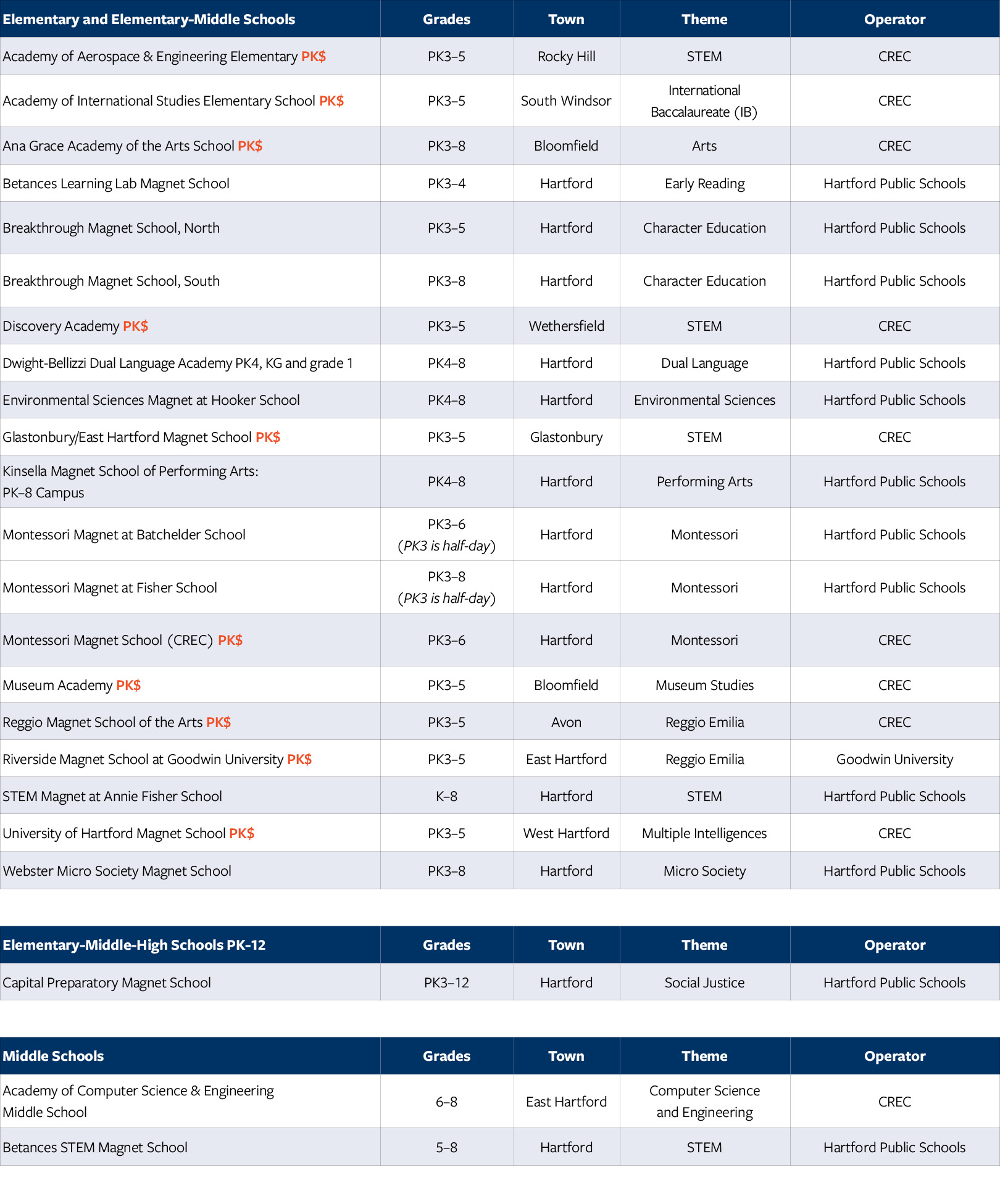
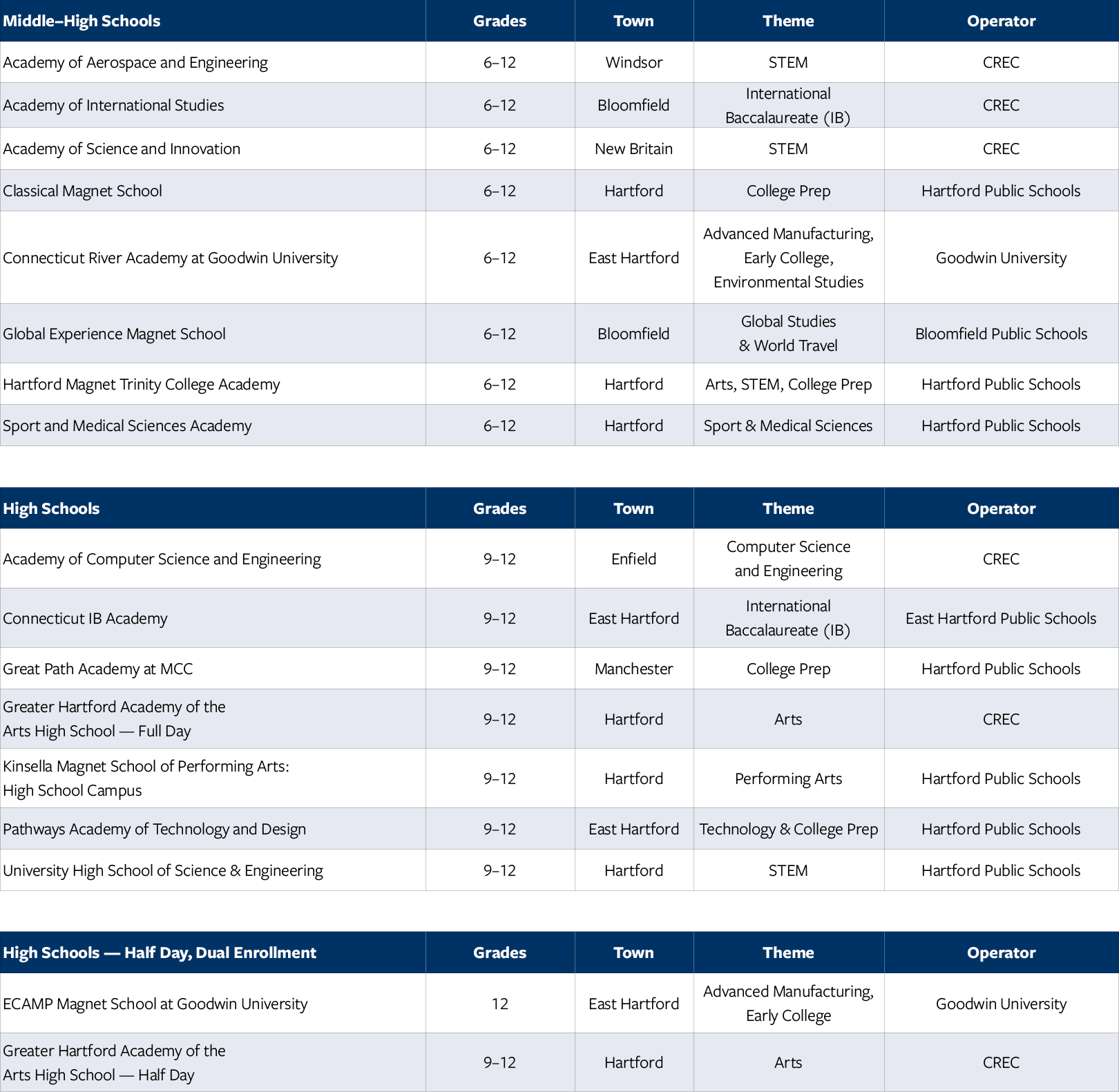

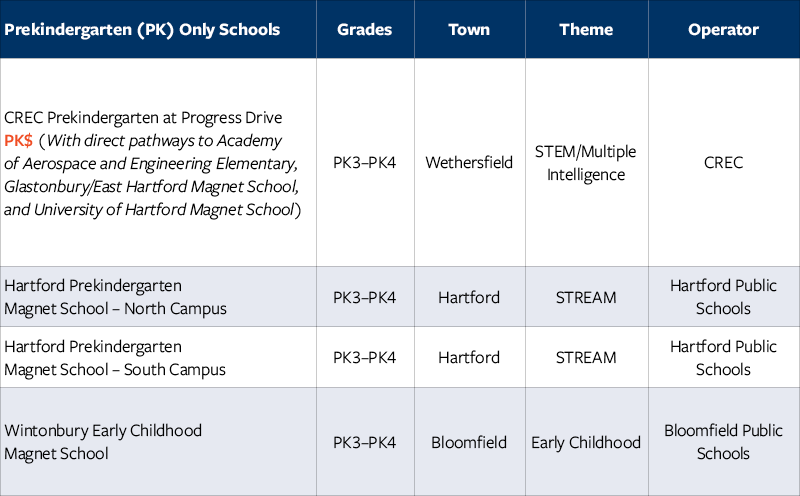
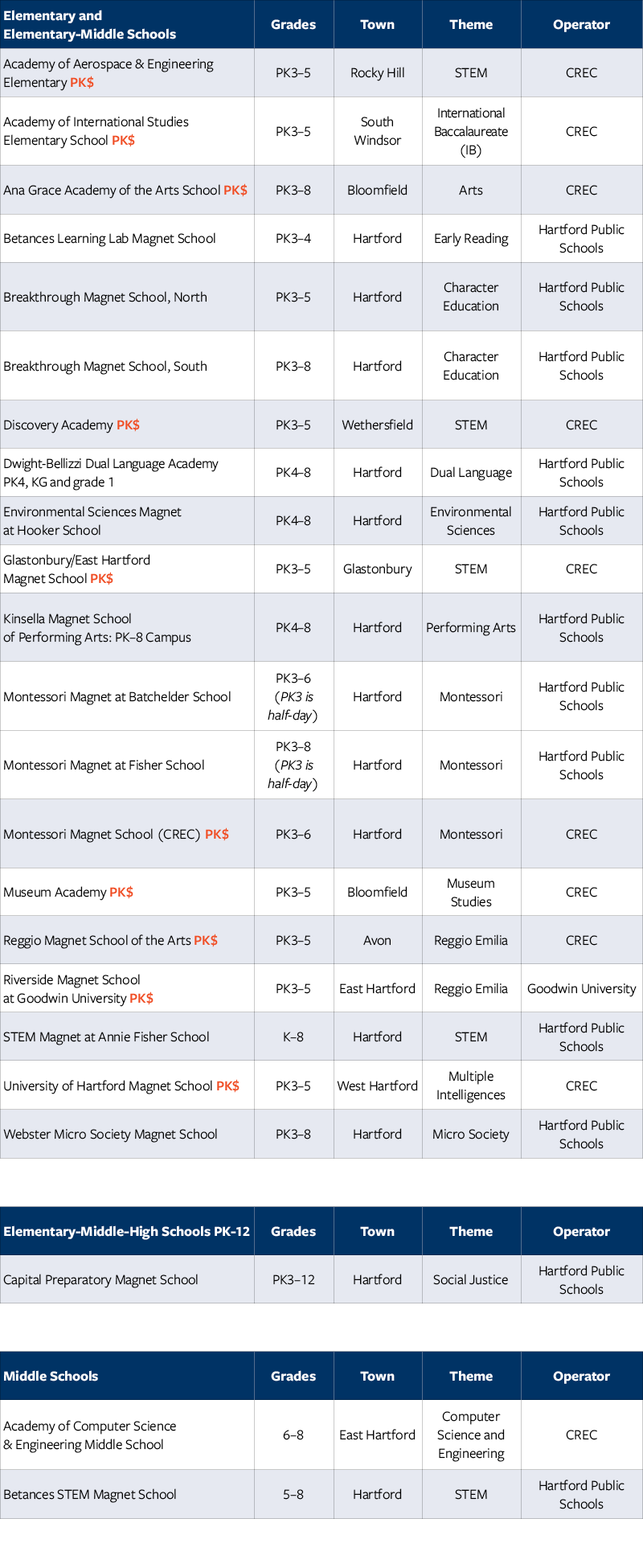
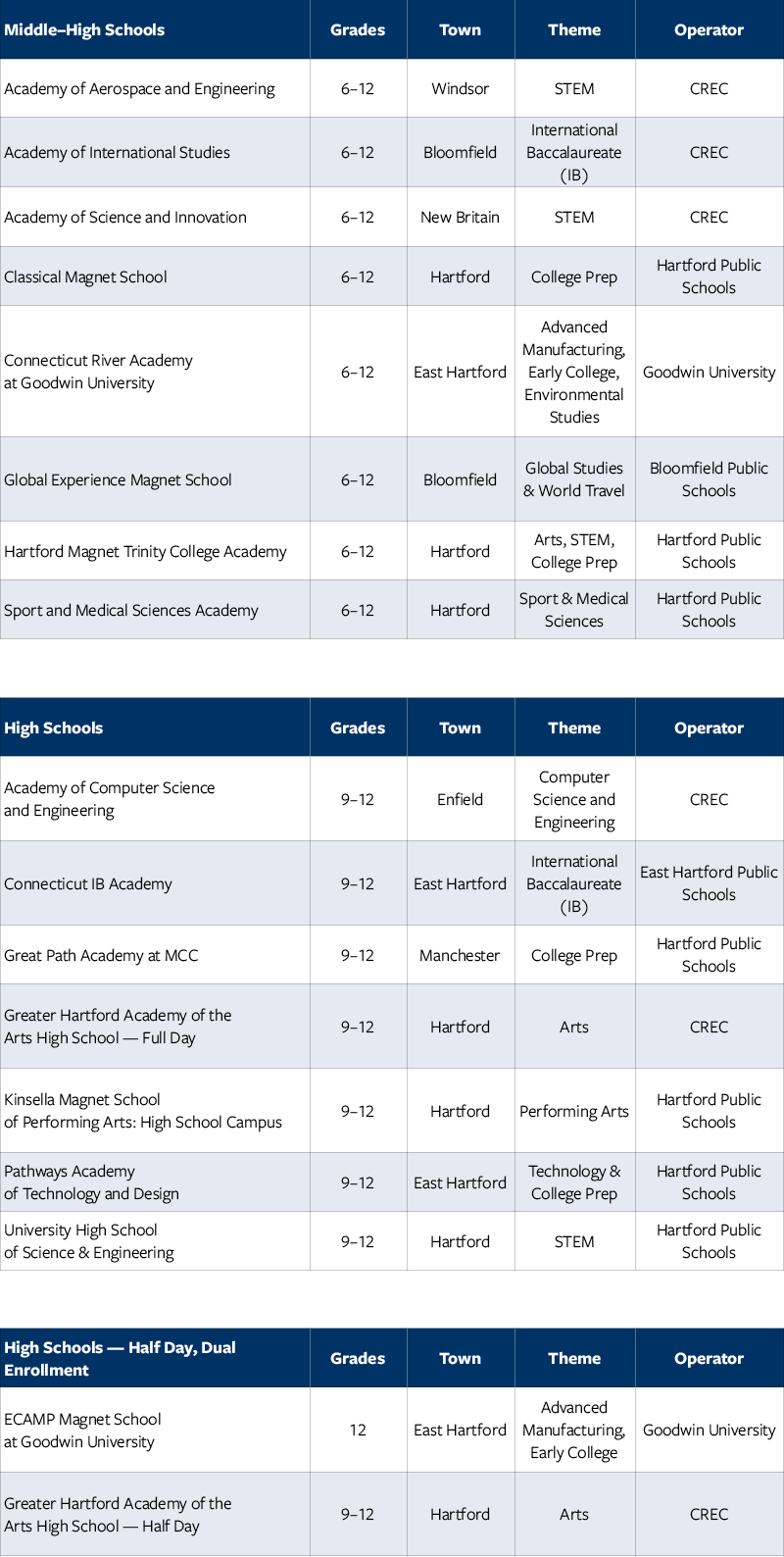
Families may choose up to 5 magnet schools on their child’s magnet school application and rank the schools in order of preference.
Magnet schools incorporate academic themes and special programming into the core curriculum to prepare students for the future, including themes like Science, Technology, Engineering and Mathematics (STEM), visual and performing arts, International Baccalaureate, and Montessori. Following is a list of just a few of the exciting and inquiry-based themes available to students through interdistrict magnet schools!
The Advanced Manufacturing theme provides students with the skills and training required for a career in the high-demand advanced manufacturing field. Through hands-on experience on state-of-the art technology equipment, students develop the skills to prepare them for future careers and/or advanced education in manufacturing, engineering, logistics, and more.
There are several magnet schools that are specifically geared toward students interested in art, music, dance, digital arts, creative writing, theater design, and other art forms. This theme integrates a rigorous core curriculum with instruction by professional artists focused on fine and performing arts.
The Character Education theme combines academic rigor with character development in a warm and welcoming environment to support active and mindful students who are confident, self-aware, cooperative and responsible decision-makers. The theme prioritizes mindfulness and good character by focusing on educating the whole child to prepare students for success in middle school, high school, and beyond as citizens and contributing members of society.
This theme offers opportunities in computer science and engineering for students to learn coding and design for websites, applications (apps), and game development – all important 21st century skills!
A dual language education creates a language immersion experience in English and Spanish during all academic classes. This approach develops language skills in English and Spanish, with the goal of bilingual fluency and bilingual literacy for our young learners.
Early College and College Preparatory themed schools focus on college and career readiness at graduation, using a college model environment and providing an early start on earning college credit.
These magnet schools are for our youngest students and focus on developing a love of learning and creating a sense of wonder about the environment, culture, and our world through hands-on learning!
Geared toward the 21st century global environment, this theme challenges students with rigorous academics and prepares them to become responsible, civic-minded citizens with intercultural understanding and respect.
The IB theme is geared toward the 21st century global environment by preparing students for college and beyond through rigorous academics, critical-thinking, and independence. IB uses the international baccalaureate learner profile to challenge students through global-minded academics to get them ready to participate in the world with intercultural understanding and respect.
Students in a MicroSociety experience a wide variety of learning environments by creating miniature societies within the school to prepare students to be engaged and active citizens. The six major components of the MicroSociety are: Technology, Economy, Academy, Citizenship and Government, Humanities and the Arts. Through active student government and academic engagement, students participate in decision-making for their school society and connect learning to the real world.
The Montessori theme offers students a nurturing and supportive learning environment that provides rigorous academic challenges while focusing on developing students’ social, emotional, academic, and physical needs. The curriculum is delivered through a hands-on approach to learning and puts students at the center of their skill development. The Montessori principles encourage respect, independence, curiosity, and diversity.
The Multiple Intelligences theme focuses on developing intelligence by allowing students to experience different ways of learning, including through linguistics, logical‑mathematical, visual‑spatial, musical, bodily‑kinesthetic, interpersonal, intrapersonal, and naturalist. These eight areas are integrated in the classroom activities and learning modules to accommodate all learning styles and build on students’ individual strengths. This mixture of intelligences provides students with the opportunity for learning based on their needs, interests, and skills.
This theme transcends the traditional classroom and creates a unique learning environment for students through partnerships with museums as an educational resource and site for exciting and stimulating excursions. The Museum Studies approach focuses on hands-on, project-based learning that individualizes content to each student’s way of learning. Students learn to think for themselves and ask questions through a strong inquiry-based and exploratory learning environment. Teachers and students participate in Visual Thinking Strategies, a museum method of observation and dialogue around formal pieces of art that develops higher-level language and thinking skills.
The Reggio theme supports an individualized learning environment inspired by the Italian Reggio Emilia approach. The curriculum is designed to respect a child’s point of view, and students are empowered to direct their learning. With the teacher acting as a guide, project-based learning opportunities inspire high levels of creativity, critical thinking, and collaborative problem solving.
The Social Justice theme promotes social and individual responsibility, global understanding, community engagement, and student empowerment. Strong academics, field experiences, and leadership skills help students develop tenacity, accomplishment, courage, community wellness, and a commitment to justice.
The Sport and Medical Science theme integrates academics and advanced technology into the learning experience with a focus on medical science in the sports context. The theme is integrated throughout the core curriculum to prepare students for advanced studies in sport medicine, exercise science, and health management.
Students interested in science, math and technology will thrive in this setting! STEM prepares students for college and careers in science, technology, engineering, and mathematics and fosters inquiring minds, logical reasoning, and great collaboration.
This theme is closely related to STEM but adds Art and Reading to the mix. STREAM focuses on inquiry-based learning and inspires students to become lifelong learners from an early age. STREAM teaches students to interact with the world through both artistic and scientific processes.
The Technology theme prepares students for the ever-changing demands of a technologically advanced global society by engaging students in the design, implementation and support of advanced technological systems and exposing them to 21st century technological skills through the core curriculum and extensive electives, such as graphic digital design, computer coding, and web design.
PK4–Grade 12
The Open Choice Program is an incredible opportunity for Hartford resident students to experience strong academic programming and enriching extracurricular options in a school district outside of Hartford. This free program allows Hartford-resident students to attend public schools in nearby suburban school districts through graduation from high school.
Hartford resident students entering PK (age 4) through Grade 10 may apply to attend school districts outside of Hartford based on their residential zone and may select up to 5 districts on their application, ranked in order of preference. Once a student is enrolled in an Open Choice school, there is no need to reapply each year. Your child is enrolled through high school graduation but must remain a Hartford resident.
View Open Choice Districts for Hartford Residents on the online school directory
There are 26 Districts that participate in the Hartford Region Open Choice Program. A family’s Hartford Residential Zone determines the school districts that will be available to them on their application.
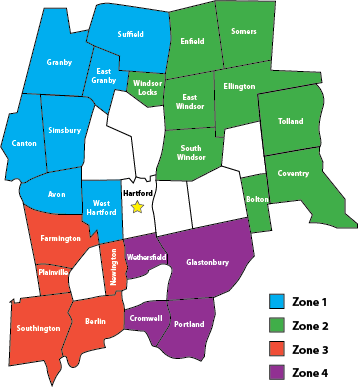
KG–Grade 8
Open Choice for Non-Hartford Residents
The Open Choice Program for Non-Hartford Residents is a free program that allows students living outside of Hartford to attend certain public schools in Hartford with unique programming. This Program offers a great opportunity for students to access the benefits of special programming while learning in culturally diverse and enriching school communities.
View Open Choice Schools for Suburban Residents on the online school directory
Hartford Region Technical High Schools (Grades 9-12)
Families with students entering grade 9 apply using the RSCO application for the three Hartford Region Technical High Schools as a region and rank the schools in order of preference.
The Hartford Region Technical High Schools provide students with the academic requirements for a high school diploma as well as hands-on skills in high-demand trade areas through challenging certification programs and industry- recognized credentials to ready them to meet Connecticut’s skilled workforce needs at graduation or go on to college, or both!
The CTECS Educational Model provides a unique educational framework that is different than a regular public school to prepare students for college and career. Unlike a traditional high school where students have 182 days to complete state-mandated academic requirements, CTECS students split their time between academics and Career and Technical Education (CTE), mastering state standards for academic courses in 91 days and trade courses in the other 91 days. Students rotate between academic and CTE courses approximately every two weeks. Ninth-grade students participate in a rotation of each of the technical programs offered at each technical high school through the Exploratory Program. This experience allows students to engage in the various career path opportunities before choosing one that will set the framework for their education in grades 10-12. As part of their CTE curriculum, students in grades 11-12 take part in the CTECS Student Workforce Program, which is designed to give students practical, hands-on experience and real-world application of learned theoretical skills.
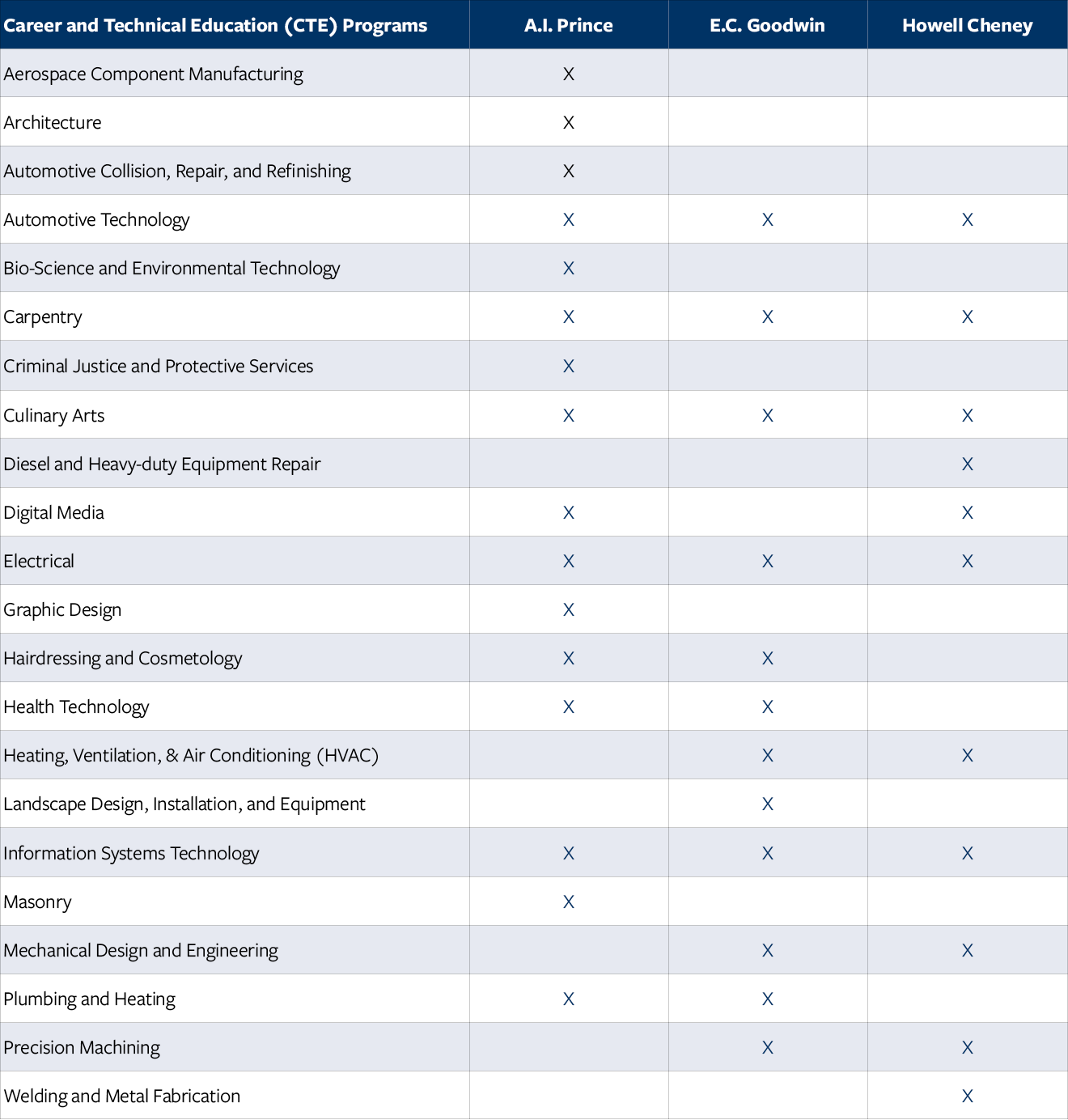

Grades 9-12
The ASTE schools prepare students for college and careers in animal science, agribusiness, agricultural mechanics, aquaculture, biotechnology, food science, marine technology, natural resources, and plant science, (not all ASTE centers offer all the same programs). These programs provide opportunities for students to receive college credit in high school. Hartford students entering 9th grade may apply to attend ASTE schools in Bloomfield, Glastonbury, and Suffield. Families apply using the separate ASTE application.
The application deadline for ASTE programs varies by school. Please refer to the ASTE application website for specific dates.
For additional program information and questions please contact each school.
ASTE Centers (9–12):
D.F. Harris Sr. Agriscience Center at Bloomfield High School
Phone: 860-286-2630 x1520
Website: D.F. Harris Sr. Agriscience Center Website
Glastonbury Regional Agriscience and Technology Center at Glastonbury High School
Phone: 860-652-7961
Website: Glastonbury AgriScience Center Website
Suffield Regional Agriscience Center at Suffield High School
Phone: 860-668-3817
Website: Suffield Agriscience Center Website

